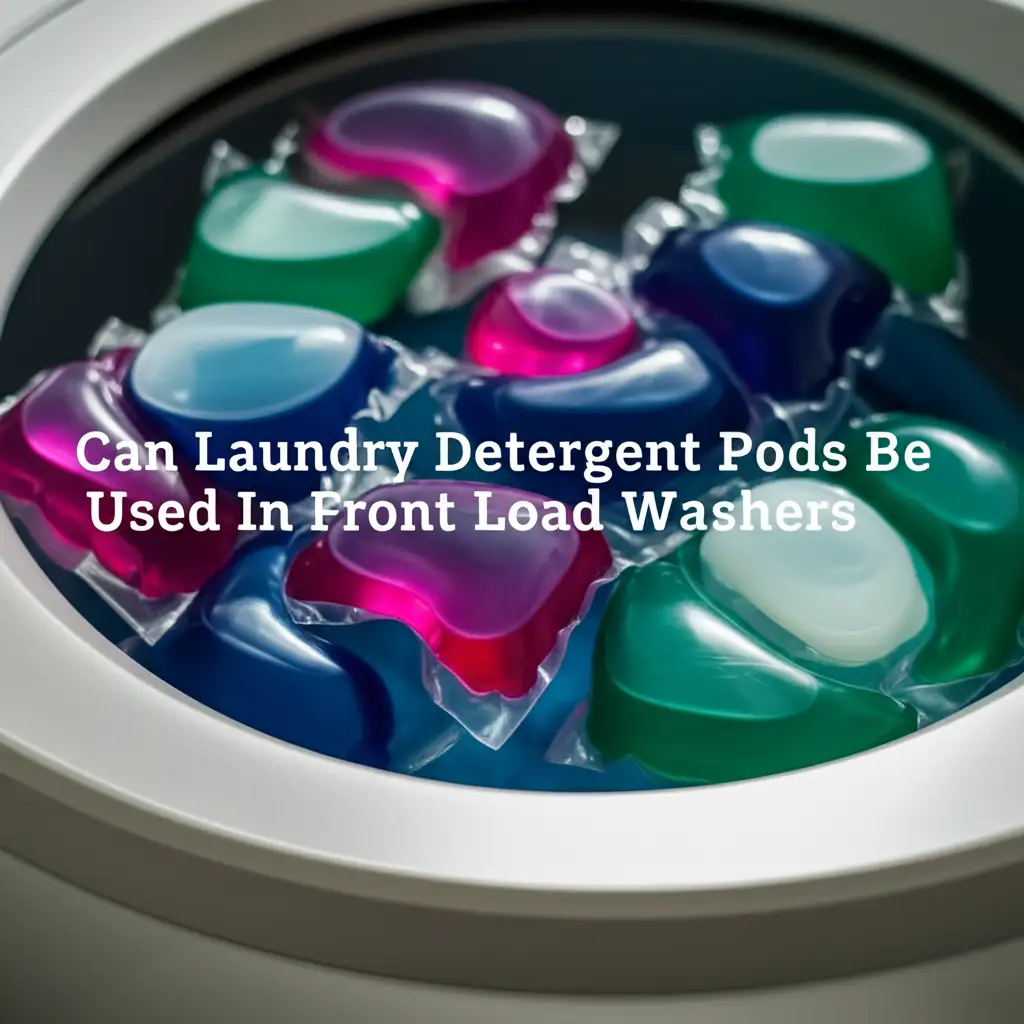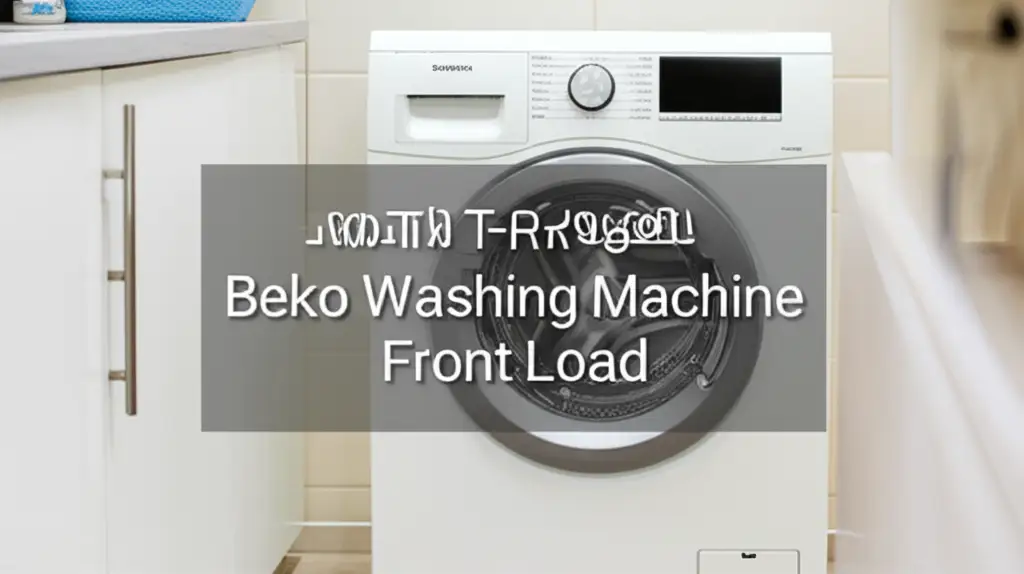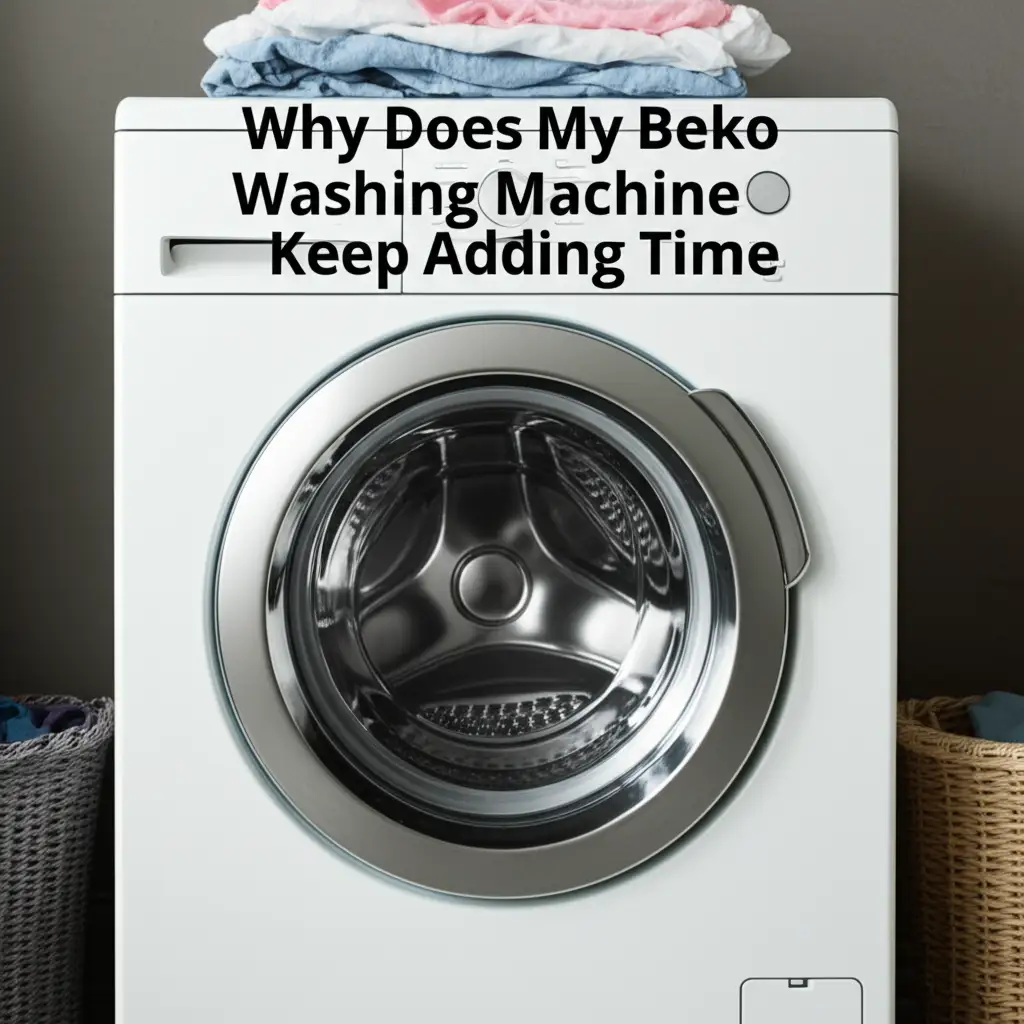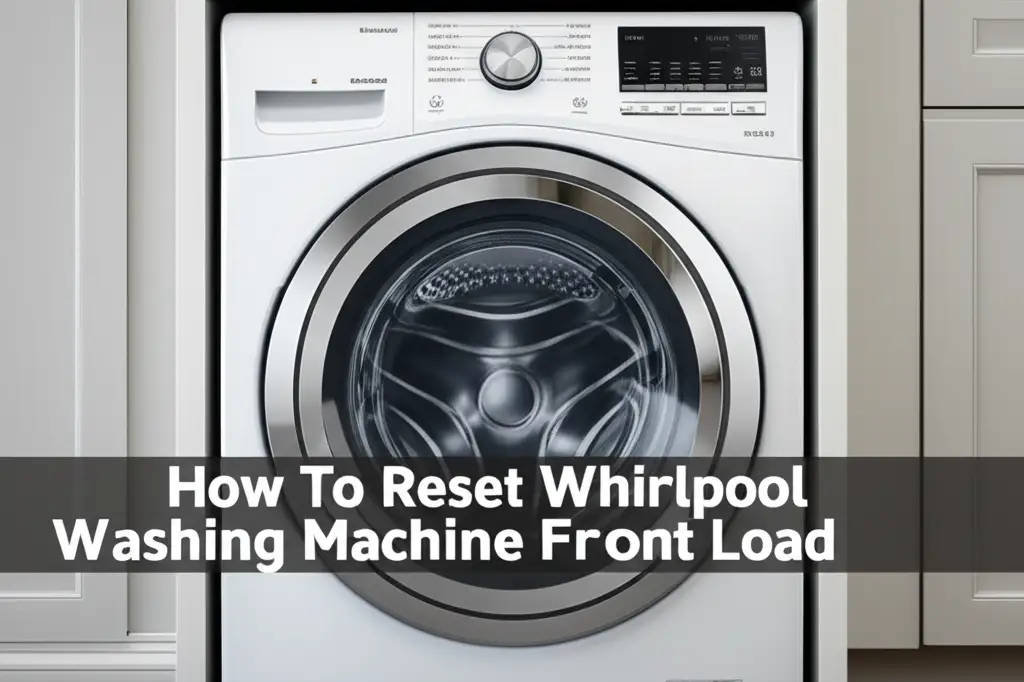· Katria Melrose · Home Appliances · 20 min read
Can Laundry Detergent Pods Be Used In Front Load Washers

Using Laundry Detergent Pods in Front Load Washers
Are you wondering if those convenient laundry detergent pods are suitable for your front load washing machine? Many people do. I often get asked this question by friends who want to simplify their laundry routine. The good news is that laundry detergent pods are specifically designed to work well in front load washers. They offer a pre-measured, mess-free solution for your washing needs.
This article will explain exactly how laundry detergent pods work in these machines. We will discuss the correct placement of pods. We will also cover proper dosage. You will learn tips for avoiding common problems like undissolved residue or excessive suds. By the end, you will understand how to use laundry pods effectively in your front loader, ensuring clean clothes and a well-maintained appliance.
Takeaway
- Yes, laundry detergent pods are safe and effective for front load washers.
- Place pods directly into the drum before adding clothes.
- Use one pod for average loads; two for very large or heavily soiled loads.
- Ensure the pod dissolves fully by avoiding overfilling the washer.
- Regularly clean your front loader to prevent residue buildup.
Yes, you can absolutely use laundry detergent pods in front load washers. These convenient, pre-measured packets are formulated to dissolve completely in the machine’s water, releasing concentrated detergent. They are a suitable and efficient option for modern, high-efficiency front-loading washing machines when used correctly.
Understanding Laundry Pods and Front Load Washer Compatibility
Laundry detergent pods offer a simple, no-mess approach to washing clothes. These small, dissolvable packets contain a precise amount of concentrated detergent, often combining cleaning agents, stain removers, and brighteners. They have become very popular due to their ease of use. You simply toss one into the wash, and you are done.
Front load washers operate differently from traditional top load machines. They use less water and rely on a tumbling action to clean clothes. This design makes them highly energy-efficient. Because they use less water, traditional liquid or powder detergents need to be carefully measured. Overdosing can lead to excessive suds, which is a common problem in these machines. Pods address this issue directly. They provide the right amount of detergent for the low water levels of a front loader. The outer film of the pod dissolves quickly when it touches water. This releases the detergent into the wash cycle right away. This design ensures the detergent disperses effectively throughout the smaller water volume.
The compatibility between laundry detergent pods and front load washers is high. Pod manufacturers design these products with high-efficiency (HE) machines in mind. HE detergents, whether liquid, powder, or pod, are low-sudsing. This prevents oversudsing, which can damage a front loader or leave residue on clothes. Using pods eliminates the guesswork of measuring liquid or powder detergent. This reduces the chance of using too much. This accuracy is a major benefit for front loaders. It helps ensure efficient cleaning without risking machine issues.
Correct Placement: Where to Put Pods in Your Front Loader
Proper placement of laundry detergent pods is critical for effective cleaning and to avoid problems. Unlike liquid or powder detergents, pods do not go in the dispenser drawer. This is a common mistake that many people make. The dispenser drawer in a front load washer is designed for liquid or powder detergents, fabric softener, and bleach. It dispenses these products at specific times during the wash cycle. Pods need immediate and full exposure to water to dissolve properly.
Always place the laundry detergent pod directly into the washing machine drum. Do this before you add your clothes. This allows the pod to dissolve quickly and completely at the start of the wash cycle. Placing it on top of the clothes or in the dispenser can cause issues. If you put the pod on top of clothes, it might get trapped. It might not dissolve fully during the wash. This can lead to detergent residue on your laundry. It can also cause a buildup inside your machine.
For the best results, open the washer door. Place the pod at the back or bottom of the empty drum. Then, load your clothes on top of the pod. This ensures the pod is covered by water quickly as the machine fills. It also helps it agitate properly with the clothes. This process makes sure the detergent is evenly distributed. It also prevents the pod’s outer film from sticking to your garments. You might see a similar recommendation when learning can you use normal detergent in Miele washing machine front load, highlighting the importance of detergent type and placement for efficient machine operation. Correct placement is a small step. However, it makes a big difference in how well laundry pods perform in a front load washer.
Dosage Matters: How Many Pods for Your Load Size
Using the correct number of laundry detergent pods is vital for clean clothes and a healthy washing machine. Overdosing can lead to excessive suds, which is bad for front loaders. It can also leave a sticky residue on your clothes or inside the washer. Undercdosing, on the other hand, means your clothes may not get clean enough. They might still have dirt or odors after washing.
The general rule is one laundry pod for a standard, average-sized load. What counts as an “average load”? It is a load that fills the drum about halfway to two-thirds full. This amount of laundry allows enough space for clothes to tumble freely. This tumbling action is crucial for efficient cleaning in a front load washer. Most pods are formulated to handle this size load effectively with their concentrated detergent.
For larger loads or very heavily soiled items, you might need two pods. A “large load” often means the drum is nearly full, but not tightly packed. Heavily soiled items include work clothes, sports uniforms, or anything with significant dirt, grease, or stains. In these cases, the extra cleaning power from a second pod helps break down grime more effectively. However, avoid using more than two pods, even for the largest loads. Too much detergent can create excessive suds. This is especially true in high-efficiency front loaders. Excessive suds can lead to:
- Residue on clothes: White streaks or a stiff feel on fabrics.
- Machine issues: The washer may run extra rinse cycles to eliminate suds, wasting water and energy. Over time, excess suds can also cause problems with the machine’s sensors or drain pump.
- Odor buildup: Leftover detergent residue can create a musty smell inside your washing machine.
Remember, the goal is optimal cleaning without oversudsing. Adjust the number of pods based on the actual load size and soil level. This ensures your clothes come out clean and your front loader operates efficiently. If you find detergent stains on your clothes, you might need to adjust your pod usage. Sometimes, detergent can stick to clothes if it does not dissolve properly. Learning how to get laundry detergent stains out of clothes after drying can be helpful if you encounter this problem.
Solving Common Pod Issues in Front Load Washers
While convenient, laundry detergent pods can sometimes cause specific issues in front load washers. Understanding these problems and their solutions helps ensure a smooth laundry experience. Two common issues are undissolved pods and excessive suds.
Undissolved Pods or Residue
This happens when the pod’s outer film does not fully dissolve. It leaves a gooey residue on clothes or inside the washer drum. There are a few reasons this occurs:
- Cold Water Cycles: Pods dissolve best in warm or hot water. If you primarily use cold water cycles, the film might not break down completely. Some pod manufacturers now offer cold-water specific formulas, which are better for low temperatures.
- Overloading the Washer: Filling the drum too tightly restricts water flow and clothes movement. The pod might get stuck between clothes and not get enough exposure to water. This prevents it from dissolving. Always leave some space for clothes to tumble.
- Incorrect Placement: As discussed earlier, placing the pod in the dispenser drawer or on top of a pile of clothes can stop it from dissolving. The pod needs to be at the bottom of the empty drum.
Solutions:
- Use Warmer Water: If possible, select a warm water setting for optimal dissolution. If you prefer cold, try a cold-water specific pod.
- Do Not Overload: Ensure you leave enough space in the drum for clothes to move freely.
- Correct Placement: Always put the pod directly into the empty drum before adding clothes.
- Pre-Dissolve (Rarely Needed): In very rare cases, if problems persist, you can drop the pod into a cup of warm water for a minute before adding it to the drum. This is usually unnecessary with modern pods.
Excessive Suds
Excessive suds are a sign of too much detergent. In a front load washer, too many suds can prevent proper tumbling, hinder rinsing, and even cause machine errors.
Reasons for excessive suds:
- Using Too Many Pods: This is the most direct cause. One pod is usually enough for an average load.
- Soft Water: If you have naturally soft water, you might need less detergent. Pods are pre-measured for average water hardness. Soft water enhances the sudsing action of detergent.
- Residue Buildup: Detergent residue inside the washer can contribute to sudsing problems over time.
Solutions:
- Reduce Pods: For average loads, stick to one pod. For smaller loads, consider switching to liquid or powder detergent for more precise measurement, or cut a pod in half if possible (though not recommended by manufacturers).
- Check Water Hardness: If you have soft water, even one pod might be too much. You may need to use less detergent overall.
- Run a Washer Cleaning Cycle: Regularly cleaning your front load washer helps remove detergent buildup. This can reduce suds and odors. I recommend doing this once a month. You can learn more about how to clean front load washer to keep your machine in top condition.
By understanding these common issues and implementing these simple solutions, you can enjoy the convenience of laundry detergent pods without compromising your wash quality or machine health.
Pods vs. Liquid/Powder: A Comparison for Front Load Washers
Choosing between laundry detergent pods, liquid, or powder for your front load washer involves weighing convenience, cost, and cleaning performance. Each type has its own set of advantages and disadvantages.
Laundry Detergent Pods
Pros:
- Convenience: Pods are pre-measured. This eliminates the need for measuring cups and reduces mess. Just toss and go.
- Portability: They are easy to carry and store, taking up less space than bulky bottles or boxes.
- Concentrated Formula: Pods often contain highly concentrated detergents, stain removers, and brighteners in one unit.
- No Spills: The sealed nature of pods prevents spills or drips. This keeps your laundry area cleaner.
Cons:
- Cost: Pods are generally more expensive per load compared to bulk liquid or powder detergents.
- Less Customization: You cannot easily adjust the dosage for very small loads or hand washing. This can lead to overuse in some situations.
- Dissolution Issues: As discussed, they can sometimes fail to dissolve fully in cold water or if the machine is overloaded.
- Safety Risk: Their bright colors and candy-like appearance pose a serious ingestion risk to young children and pets. Proper storage is crucial.
Liquid Detergent
Pros:
- Versatility: You can easily adjust the amount of detergent for different load sizes and soil levels. This makes it ideal for very small, very large, or heavily soiled loads.
- Stain Treatment: Liquid detergent can be used for pre-treating stains directly on fabric before washing.
- Dissolves Easily: It dissolves well in all water temperatures, including cold water.
Cons:
- Measuring Mess: Requires careful measurement, which can lead to spills and sticky residue around the dispenser.
- Bulkier Storage: Bottles take up more space and can be heavy.
- Overdosing Risk: It is easy to use too much, leading to excessive suds in HE front loaders.
Powder Detergent
Pros:
- Cost-Effective: Often the most economical option per load, especially when bought in bulk.
- Good for Hard Water: Some powder detergents contain water softeners, which can be beneficial in hard water areas.
- Good for Heavily Soiled Clothes: Powder detergents can be very effective at removing heavy dirt and grime.
Cons:
- Dissolution Issues: Can sometimes leave powdery residue on clothes, especially in cold water or if not fully dissolved.
- Measuring Mess: Similar to liquid, it requires measuring and can be dusty or messy.
- Less Convenient: Not as easy to use as pods.
For front load washers, both pods and HE liquid detergents are excellent choices due to their low-sudsing formulations. Pods offer unmatched convenience. Liquid offers flexibility in dosing. Powder can be good for budget-conscious users or those with hard water, provided it dissolves properly. Your choice depends on your priorities: convenience, cost, or customization. For optimal results with bedding, it’s wise to consider specific guidance, such as how many Tide Pods for bedding, to ensure adequate cleaning without over-sudsing large items.
Maintaining Your Front Loader When Using Pods
Proper maintenance is essential for any washing machine, especially front loaders, to prevent odors and ensure longevity. When using laundry detergent pods, specific maintenance steps become even more important. While pods are convenient, they can still contribute to residue buildup if not used correctly or if the machine is not cleaned regularly.
Front load washers are known for their efficiency but also for potential issues with mold, mildew, and odors. These problems often stem from moisture trapped inside the drum and detergent residue. The rubber gasket around the door is a common spot for this. Undissolved pod residue, lint, and moisture can accumulate there. This creates a breeding ground for bacteria and mold. Over time, this buildup causes unpleasant smells in your washer and on your clothes.
Regular cleaning prevents these issues. Here are key maintenance tips when using pods in your front loader:
- Wipe Down the Gasket: After every few washes, or at least weekly, wipe the rubber gasket around the door. Use a damp cloth to remove any moisture, lint, or detergent residue. Pay attention to the folds and crevices. This simple step significantly reduces mold and mildew growth. You can find detailed instructions on how to clean front load washer gasket.
- Leave the Door Ajar: After finishing laundry, leave the washer door slightly open. This allows air to circulate inside the drum. It helps the interior dry completely. This prevents moisture from becoming trapped, which causes musty smells.
- Clean the Dispenser Drawer: Even if you do not use the dispenser for pods, sometimes water can sit there. It is good practice to remove and clean the dispenser drawer periodically. Check for any mold or residue buildup.
- Run a Washer Cleaning Cycle: Most front load washers have a dedicated “Clean Washer” or “Tub Clean” cycle. Use this cycle monthly. It runs with hot water and often uses a special washer cleaning tablet or white vinegar to flush out detergent buildup, mold, and odors. If your machine does not have a specific cycle, run an empty cycle on the hottest water setting. Add a cup of white vinegar or a washer cleaning product to the detergent dispenser. This helps remove residues from the tub, hoses, and pump. Maintaining a clean machine is crucial for preventing foul odors and ensuring your clothes are truly clean. Learn more about general machine cleaning by checking out tips on how to clean laundry machine.
- Check the Drain Filter: Periodically check and clean the drain filter (also called a coin trap). This filter traps small items like coins, lint, and pet hair before they can clog the pump. A clogged filter can lead to drainage issues and odors. The location of this filter varies by model, so consult your washer’s manual.
By adopting these maintenance practices, you ensure your front load washer remains fresh and functions efficiently. This maximizes the benefits of using laundry detergent pods. You will enjoy consistently clean clothes and a well-maintained appliance for years to come.
Choosing the Right Pods for Your Front Load Washer
Selecting the right laundry detergent pods makes a difference in your wash results and machine health. Not all pods are created equal. Understanding the varieties and what to look for helps you make an informed choice.
High-Efficiency (HE) Specific Pods
Most laundry pods on the market today are designed for high-efficiency (HE) machines. Front load washers are almost always HE. HE detergents produce very few suds. This is important because front loaders use much less water than traditional top loaders. Excessive suds in a low-water environment can lead to issues. It can prevent proper tumbling and rinsing. Always look for the “HE” symbol on the packaging. This ensures the pod is suitable for your machine. Using non-HE pods in a front loader can cause oversudsing. This leads to residue on clothes and potential damage to the washer’s sensors over time.
Pods for Different Water Temperatures
Some pods are formulated to dissolve better in cold water. If you frequently wash clothes using cold water cycles, seek out “cold water” or “cool water” specific pods. These pods use advanced film technology that breaks down more readily at lower temperatures. Standard pods might struggle to dissolve completely in cold water, leaving gel-like residue on your clothes. Always read the packaging to confirm suitability for your preferred wash temperature.
Scented vs. Unscented Pods
Laundry pods come in a wide range of scents, from fresh linen to exotic florals. The choice is a matter of personal preference. However, if you or family members have sensitive skin or allergies, opt for unscented or “free and clear” pods. These products are formulated without dyes and perfumes. They reduce the risk of skin irritation. Unscented pods still clean effectively. They just do not leave a fragrance behind.
Single-Dose vs. Multi-Chamber Pods
Most pods are single-chamber, containing a concentrated detergent. Some brands offer multi-chamber pods. These pods separate different components, like detergent, stain remover, and brightener, until they dissolve in the wash. Both types work effectively. Multi-chamber pods might offer slightly enhanced performance for stain removal or brightening due to the specialized compartments.
Tips for Choosing:
- Read Reviews: Check online reviews for dissolution performance, scent strength, and cleaning effectiveness.
- Consider Your Needs: Do you need extra stain fighting, or are you sensitive to scents?
- Start Small: Buy a small pack first to test if the brand works well with your machine and water conditions.
By being mindful of these factors, you can select laundry detergent pods that not only clean your clothes effectively but also keep your front load washer running smoothly.
Troubleshooting Pod Performance: Advanced Tips
Even with correct usage, you might encounter performance issues with laundry detergent pods in your front load washer. These advanced tips address less common problems. They help ensure your pods work as intended.
Hard Water Considerations
Hard water contains high levels of minerals like calcium and magnesium. These minerals can reduce the effectiveness of detergents. They can also contribute to residue buildup. If you live in an area with hard water, you might notice:
- Clothes not feeling as clean.
- Detergent residue more frequently.
- More suds than expected (counter-intuitively, hard water reduces sudsing action, but it can also cause undissolved detergent to appear as residue).
Solution: Consider using a water softener product in conjunction with your pods. Some pods are formulated with water softeners, so look for those labels. Alternatively, adding a small amount of borax or washing soda directly to the drum with the pod can help. These additives boost cleaning power in hard water. They also help the detergent work more efficiently.
Washer Load Sensing Issues
Modern front load washers often have load-sensing technology. This feature determines the optimal water level based on the weight of the clothes. If a pod does not dissolve correctly due to low water levels, this could be a factor.
Solution: For particularly small loads, or if you consistently experience dissolution issues, select a cycle that uses slightly more water. Some machines offer a “deep fill” or “extra rinse” option. Using these occasionally can help ensure full dissolution and rinsing, even with pods. However, be mindful that these cycles use more water and energy. Using the correct number of pods for your load size is usually enough.
Temperature Consistency
While some pods are designed for cold water, consistent cold water usage over time can lead to a buildup of detergent residue and bio-film in your machine.
Solution: Even if you prefer cold water washes, run a hot water cycle (empty or with towels) at least once a month. Add a cup of white vinegar or a specialized washing machine cleaner to this cycle. This “maintenance wash” helps to:
- Break down grease and soap scum.
- Eliminate odors.
- Sanitize the drum and internal components.
This keeps your machine clean and prevents residue from interfering with pod performance. Regular maintenance like this is part of learning how to clean front load washer effectively.
Pod Storage
The way you store your laundry pods matters. Pods are designed to dissolve when they come into contact with water. High humidity or moisture in your laundry area can cause the outer film to start dissolving prematurely. They might stick together in the container.
Solution: Store pods in their original airtight container. Keep them in a cool, dry place. Avoid storing them near the washer where humidity is higher. This ensures each pod is ready for use and maintains its integrity until it hits the water inside the drum.
By addressing these advanced troubleshooting tips, you can fine-tune your laundry routine with pods. You can resolve persistent issues. This helps ensure your front load washer performs at its best.
Frequently Asked Questions
Can I put laundry pods in the dispenser drawer of a front load washer?
No, do not put laundry pods in the dispenser drawer. The dispenser drawer is for liquid or powder detergent, fabric softener, and bleach. Pods need direct contact with water to dissolve correctly. Place the pod directly into the washing machine drum before adding your clothes. This ensures it dissolves fully and effectively.
How many pods should I use for a king-size comforter in a front load washer?
For a king-size comforter, which counts as a very large or heavily soiled load, you should typically use two laundry pods. Ensure the comforter is not packed too tightly in the drum. This allows enough space for the comforters to tumble. It also helps the pods dissolve properly.
Why do my laundry pods sometimes not dissolve in my front load washer?
Laundry pods may not dissolve due to several reasons. These include using too much cold water, overloading the washing machine, or incorrect placement. Ensure you place the pod directly in the drum before clothes. Use warm water when possible. Avoid packing the drum too full.
Do laundry pods leave residue on clothes in front load washers?
Pods can leave residue if they do not dissolve completely. This often happens from cold water washing, overloading the machine, or improper placement. If you see residue, try warmer water, reduce your load size, or ensure the pod goes into the empty drum first. Regular machine cleaning also helps.
Are laundry pods safe for septic systems when used in front load washers?
Yes, most laundry detergent pods are safe for septic systems. Look for pods labeled “septic safe” or “HE” (High-Efficiency). HE detergents are low-sudsing and biodegradable, which is good for septic systems. Always confirm the product’s specific labeling if you have concerns about your septic system.
Can using pods harm my front load washer?
No, using HE-specific laundry pods correctly will not harm your front load washer. They are designed for these machines. However, improper use, like excessive suds from too many pods or residue from undissolved pods, can lead to maintenance issues over time. Regular cleaning and proper dosage are key to preventing problems.
Conclusion
Using laundry detergent pods in front load washers is not just possible; it is often the most convenient and effective method for many households. I have found this to be true in my own laundry routine. Pods are specifically formulated to work with the low water levels of high-efficiency front loaders. This ensures efficient cleaning without the mess or guesswork of traditional detergents. The key to success lies in understanding proper usage.
Remember to always place laundry detergent pods directly into the empty washing machine drum before adding clothes. Use one pod for average loads. You can use two pods for very large or heavily soiled laundry. Be mindful of potential issues like undissolved residue or excessive suds. These problems often stem from cold water washes





